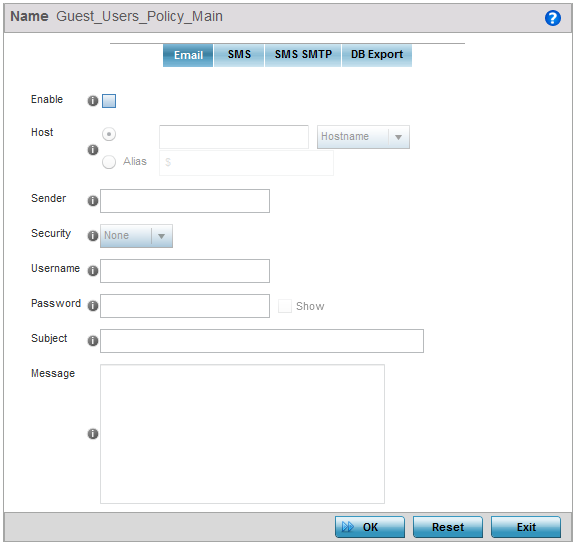About this task
To define a guest management configuration using email as the primary key for authentication:
Procedure
-
Select Configuration > Services > Guest Management.
Review existing guest management configurations to determine whether new email configuration requires creation or an existing guest user configuration requires modification or deletion.
-
Select the Email tab.
 Guest Management - Add/Edit - Email Tab
Guest Management - Add/Edit - Email Tab
-
Set the following email guest user network address and message content
information required for notifying a guest with a passcode using email:
Enable Enable this option so guest users can register themselves with their email credentials as a primary key for authentication; captive portal system provides the pass code for their registration and the guest users needs to use the registered Email/ mobile/member id and the received pass code for further login to the captive portal. This setting is disabled by default and must be enabled to define the required settings. Host Define a hostname or IPv4 formatted IP address of the SMTP server resource used for guest management email traffic, guest user credential validation and passcode reception. Optionally create an alias to define the host once and use the alias across different configuration items. Sender Provide a 100 character maximum sender name for the guest user receiving the passcode required for registering their guest email credentials. Security Use the drop-down menu to select ssl or starttls as the email host server user authentication validation scheme for this particular username and password combination. Optionally select None to apply to no additional user authentication beyond the required username and password combination. Username Provide a unique 100 character maximum username unique to this guest management configuration. This username will require its own password and must be correctly provided to receive the required passcode for registering guest email credentials. Password Define a 63 character maximum password that must be correctly provided with the unique username to receive the required passcode for registering guest email credentials. Subject Enter the 100 character maximum email subject for the email message sent to the guest user along with the required passcode. You can use the tag ‘GM_NAME‘ in the subject which is replaced by the guest user‘s name. Message Create the 1024 character maximum message content for the email sent to the guest user along with the passcode. You can use the following tags in the message body. - GM_NAME – indicates the guest user‘s name in the message. This tag is replaced by the guest user‘s name when the email is created.
- GM_PASSCODE - indicates the password assigned to the user. The tag is replaced by the actual password when the email is created.
- CR-NL - indicates a line break. When used, the word next to this tag starts on a new line when the email is created.
-
Click OK to save the updates to the guest management
Email configuration.
Click Reset to revert the screen back to its last saved configuration.
